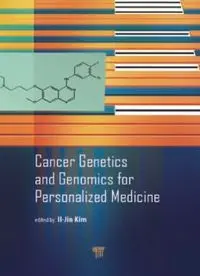
Cancer genetics and genomics for personalized medicine PDF
Preview Cancer genetics and genomics for personalized medicine
Cancer Genetics and Genomics for Personalized Medicine Cancer Genetics and Genomics for Personalized Medicine editors Preben Maegaard edited by Anna Krenz Wolfgang Palz II-Jin Kim The Rise of Modern Wind Energy Wind Power for the World Published by Pan Stanford Publishing Pte. Ltd. Penthouse Level, Suntec Tower 3 8 Temasek Boulevard Singapore 038988 Email: Contents Preface xiii 1 Personalized Medicine for Cancer: Introduction and Overview of the Book 1 Il-Jin Kim and David Jablons 1.1 Changing the Treatment Paradigm for Cancer 1 1.2 Companion Diagnostics and New Sequencing Technologies 3 1.3 Early Detection of Cancer and Tumor Recurrence Monitoring: Circulating Tumor Cell (CTC) and Circulating Tumor DNA (ctDNA) 5 1.4 Cancer Animal (Mouse) Models and Microenvironment for Personalized Medicine 6 1.5 Personalized Immunotherapy 7 1.6 Hereditary Cancer Syndromes and Potential Treatment 7 1.7 Future Directions 8 2 Personalized Medicine in Lung Cancer 15 Daniela Morales-Espinosa, Silvia Garc´ıa-Roma´n, and Rafael Rosell 2.1 Introduction 15 2.1.1 Predictive Models 16 2.1.2 The Molecular Diagnostics Approach 17 2.1.3 Conventional Chemotherapy 19 2.1.3.1 Cisplatin 19 2.1.3.2 Pemetrexed 20 vi Contents 2.1.3.3 Gemcitabine 21 2.1.3.4 Taxanes 22 2.2 Genetic Alterations and New Potential Targets 23 2.2.1 Receptor Tyrosine Kinases 24 2.2.1.1 EGFR inhibitors (first and second generation) 24 2.2.1.2 ALK rearrangement (first and second generation) 25 2.2.1.3 ROS1 26 2.2.2 Epigenetic Factors 27 2.2.3 Transcription Factors 30 2.2.4 Repurposing Drugs 32 2.3 Conclusions 33 3 Genome-Based Personalized Medicine in Liver Cancer 39 Jae-Jun Shim and Ju-Seog Lee 3.1 Introduction 39 3.1.1 Epidemiology of Liver Cancer 39 3.1.2 Clinical Characteristics of Liver Cancer 40 3.2 Why Personalized Medicine is Important in Patients with Liver Cancer? 41 3.3 Methods and Results of Genomic Profiling of Liver Cancer 42 3.3.1 Comparative Genomic Hybridization (CGH) 42 3.3.2 Microarray-Based Technology 43 3.3.3 Next-Generation Sequencing 44 3.3.4 Integromics: Integration of Multiple -omic Data 45 3.4 Conclusion 47 4 Applications of Circulating DNA Analysis in Personalized Medicine 53 Dana W. Y. Tsui and Muhammed Murtaza 4.1 Biological Characteristics of Circulating DNA 53 4.1.1 History 53 4.1.2 Biological Characteristics 54 4.2 Molecular Methods for Circulating DNA Analysis 55 4.3 Circulating Tumor-Specific DNA in Cancer Patients 58 Contents vii 4.3.1 Monitoring of Tumor Burden and Disease Response 58 4.3.2 Molecular Stratification for Targeted Therapies 59 4.3.3 Analysis of Clonal Evolution and Therapeutic Resistance 60 4.4 Circulating DNA for Noninvasive Prenatal Diagnostics 60 4.4.1 Noninvasive Diagnosis of Fetal Genetic Diseases 61 4.4.2 Noninvasive Prenatal Diagnosis of Down-Syndrome 61 4.4.3 Noninvasive Sequencing of the Fetal Genome 62 4.4.4 Clinical Implementation of Prenatal Diagnosis 63 4.5 Circulating DNA in Transplant Recipients 63 4.6 Pre-analytical Considerations 63 4.7 Conclusion 65 5 Circulating Tumor Cells and Personalized Medicine 77 Jin Sun Lee, Mark Jesus M. Magbanua, Marc R. Jabon, and John W. Park 5.1 Metastasis and Circulating Tumor Cells 77 5.1.1 The Metastatic Process 78 5.1.2 Circulating Tumor Cells 79 5.2 Enrichment and Detection of CTCs 79 5.2.1 Enrichment 80 5.2.2 Detection 82 5.2.2.1 Immuno-cytomorphological approach: Immunocytochemistry (ICC) 82 5.2.2.2 Molecular approach: Real-time reverse transcription polymerase chain reaction (RT-PCR) 84 5.3 Clinical Implications of CTC Detection and Enumeration 84 5.3.1 Breast Cancer 85 5.3.2 Prostate Cancer 86 5.3.3 Colorectal Cancer 87 5.3.4 Lung Cancer 88 5.4 Molecular Characterization of CTC and Personalized Medicine 89 viii Contents 5.4.1 Tumor Biomarkers in CTCs 89 5.4.2 Molecular Analysis of CTCs 90 5.4.3 Clinical Trials for Personalized Medicine 90 5.5 Summary 92 6 Mouse Models in Personalized Cancer Medicine 103 M. E. Beaulieu, T. Jauset, D. Masso´ -Valle´s, L. Soucek, and J. R. Whitfield 6.1 Transgenic Mouse Models: From Understanding the Molecular Basis of Tumorigenesis to the Refinement of Drug Design Targeting Specific Mutated/Altered Proteins 104 6.1.1 Prenatal GEMMs 105 6.1.1.1 Tissue-specific promoters and CRE recombinase technology 105 6.1.2 Postnatal GEMMS 107 6.1.2.1 Irreversible models: Inducible CRE recombination 107 6.1.2.2 Switchable models: The tetracycline inducible system 108 6.1.2.3 The estrogen-receptor system 110 6.1.3 GEMMs: Benefits and Drawbacks 111 6.2 Patient-Derived Xenograft (PDX): Tumor Heterogeneity and the Exploration of Avatars as Predictors of Treatment Outcome 112 6.2.1 Starting Material 113 6.2.2 Mode of Implantation 115 6.2.3 Recipient Mouse Strains 116 6.2.4 PDXs in Personalized Medicine 117 6.2.5 PDXs: Limitations and Value 121 6.3 Humanized Mouse Models: Bringing the Major Players Back into the Biological Game 122 6.3.1 The Need for Better Models 122 6.3.2 “Humanizing” the Mouse Models 123 6.3.3 Transplantation of Hematopoietic Stem Cells 124 6.3.4 Transplantation of Peripheral Blood Mononuclear Cells 125 6.3.5 Local “Humanization” 125 Contents ix 6.3.6 Overcoming Limitations of the Model 126 6.3.7 Success Stories 126 6.3.8 Humanized Mouse Models: Future Perspectives 128 6.4 Discussion and Perspectives 128 7 Tumor Microenvironment, Therapeutic Resistance, and Personalized Medicine 145 Yu Sun 7.1 TME Orchestrates Disease Progression and Dominates Therapeutic Response 146 7.1.1 Cancer-Associated Fibroblasts 147 7.1.2 Vasculature System 148 7.1.3 Extracellular Matrix 148 7.1.4 Immune Cells 149 7.1.5 TME-Derived Exosomes 151 7.2 Treatment-Activated TME Confers Acquired Resistance and Creates Barriers to a Clinical Cure 154 7.2.1 Damage Responses of the TME Offset Therapy-Enforced Tumor Regression 154 7.2.2 Modified Differentiation and Immune Responses in the TME Decrease Therapeutic Outcomes 157 7.3 Overcoming Challenges of Personalized Cancer Therapy Requires Translation of Biological Insights into the Clinic 158 7.3.1 Implications of Personalized Cancer Therapy in an Era of Precision Medicine 158 7.3.2 Significance of Preclinical Studies in Promoting PCT Advancement 163 7.4 Concluding Remarks and Future Outlooks 165 8 Personalized Immune Therapy 175 Joost Hegmans, Lysanne Lievense, and Joachim Aerts 8.1 Immunotherapy 176 8.2 Immune Cell Involvement during Carcinogenesis 177 8.3 Context-Specific Nature of Immune Cells within Tumors 177
